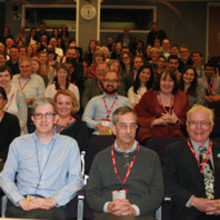Legionella turns 40
Issue: Future Tech
09 August 2016 article

2016 marks the 40th year since the now infamous outbreak at the 58th American Legion’s convention, Bellevue-Stratford Hotel, Philadelphia, USA, in 1976 resulting in many unexplained deaths. It was Joseph McDade, a specialist in rickettsia at the Centers for Disease Control and Prevention (CDC), Atlanta, USA, who along with his team finally discovered the causative agent, the Legionnaires’ disease (LD) bacterium, by inoculating guinea pigs with clinical material from patients. This bacterium was later formally named as Legionella pneumophila.
To mark this milestone, Public Health England (PHE) arranged a one-day symposium at Colindale, London, on 31 March 2016 called ‘Legionella pneumophila (1976 to 2016) – from whole guinea pigs to whole genome sequencing’. The aim was to bring together Legionella experts and those with an interest in Legionella to gain new insights, particularly concerning the application of the new disruptive technology of whole genome sequencing (WGS) to public health.
The opening presentation was by Professor Jacob Moran-Gilad on ‘Legionellosis in Israel - it’s not the heat, it’s the humidity’, which covered an infant death due to LD caused by a domestic humidifier. Next, Dr Valeria Gaia presented ‘Legionella: the Swiss experience’ and described the link between increased incidence of LD and climate conditions. Dr Sophie Jarraud reported on an investigation into one of the largest LD outbreaks in France in 2004, illustrating new insights gained from the application of WGS analyses. Dr Natalia Kozak-Muiznieks, from the CDC, illustrated how both the current consensus typing method, sequence-based typing (SBT), and WGS analysis of a US healthcare-associated outbreak, led to a revisiting of the concept of L. pneumophila subspecies. Sophia David, a final-year PhD student (Sanger Institute/PHE), described the evaluation of WGS for the epidemiological typing of L. pneumophila and the rationale for a new core genome WGS scheme. The next speaker was Sharon Carney, a first-year PhD student (Imperial College London/PHE), who presented the application of metagenomics for improved detection of Legionella in low-abundance specimens. In May–July 2012, a large LD outbreak occurred in Edinburgh, Scotland. Professor J. Ross Fitzgerald presented data on WGS analysis of the clinical isolates, which revealed subtypes within a single sequence type, raising the possibilities of diversification within a single environmental source or multiple point sources. The title of Professor Julian Parkhill’s talk was ‘Recent emergence of L. pneumophila disease-associated clones: what does it mean?’, with the somewhat controversial hypothesis that the only possible explanation is that human infection is involved in the transmission cycle. Finally, the day also marked the retirement of Dr Tim Harrison who gave his insightful ‘Reflections from the Legionella Reference Laboratory’.
Acknowledgments
Special thanks to Professor Maria Zambon, PHE Directorate and Microbiology Society for financial support; Professor Nick Phin and Dr Tim Harrison (Chairs), Mark Greenley (audio visual support), Sheila Culkin (administrative support) and Kastro Doda (catering).
NORMAN FRY
Deputy Head, Respiratory and Vaccine Preventable Bacteria Reference Unit, PHE Colindale, London NW9 5EQ, UK
[email protected]
This event was supported by the Society via a Society-Supported Conference Grant. Find out about other Society-Supported conferences taking place this year and how you could apply for a grant for your event on our website.
Image: Delegates attending the Legionella symposium at Colindale. Mark Greenley..
